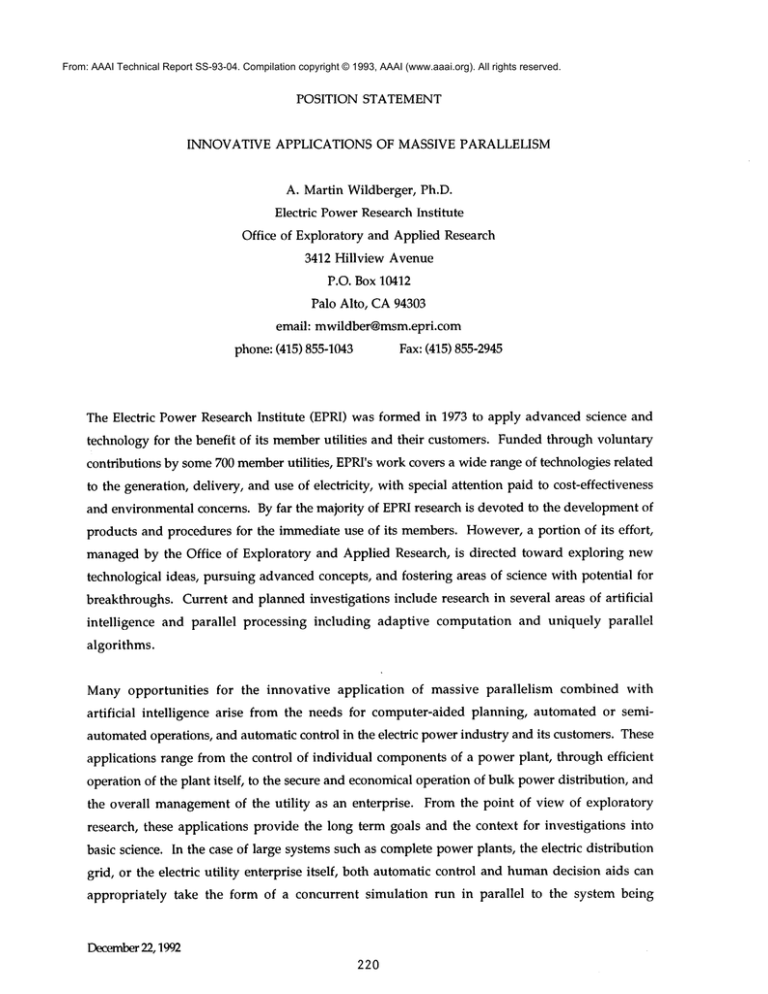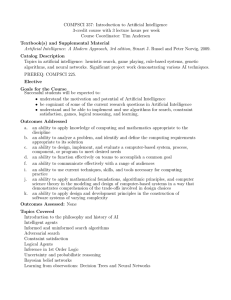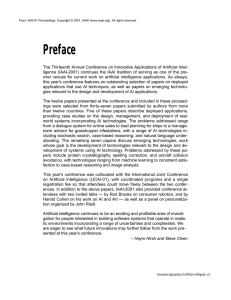
From: AAAI Technical Report SS-93-04. Compilation copyright © 1993, AAAI (www.aaai.org). All rights reserved.
POSITION
STATEMENT
INNOVATWE APPLICATIONS
OF MASSIVE PARALLELISM
A. Martin Wildberger, Ph.D.
Electric Power Research Institute
Office of Exploratory and Applied Research
3412 Hillview
Avenue
P.O. Box 10412
Palo Alto, CA94303
email:
mwildber@msm.epri.com
phone: (415) 855-1043
The Electric
Power Research Institute
Fax: (415) 855-2945
(EPRI) was formed in 1973 to apply advanced science and
technology for the benefit of its member utilities
contributions
by some 700 memberutilities,
and their customers. Funded through voluntary
EPRrs work covers a wide range of technologies related
to the generation, delivery, and use of electricity,
with special attention paid to cost-effectiveness
and environmental concerns. By far the majority of EPRI research is devoted to the development of
products and procedures for the immediate use of its members. However, a portion of its effort,
managed by the Office of Exploratory
technological
ideas, pursuing advanced concepts, and fostering
breakthroughs.
intelligence
and Applied Research,
Current and planned investigations
and parallel
processing
is directed
toward exploring
areas of science with potential
new
for
include research in several areas of artificial
including
adaptive
computation
and uniquely
parallel
algorithms.
Many opportunities
artificial
intelligence
automated operations,
applications
for the innovative
arise
research,
of massive parallelism
from the needs for computer-aided
and automatic control in the electric
range from the control of individual
operation of the plant itself,
the overall
application
automated or semi-
power industry and its customers. These
components of a power plant,
through efficient
to the secure and economical operation of bulk power distribution,
management of the utility
these applications
planning,
combined with
as an enterprise.
From the point of view of exploratory
provide the long term goals and the context for investigations
basic science. In the case of large systems such as complete power plants, the electric
grid, or the electric
appropriately
utility
enterprise
itself,
take the form of a concurrent
and
into
distribution
both automatic control and humandecision aids can
simulation
December22,1992
220
run in parallel
to the system being
controlled. In order to be effective for optimization, the simulation must be able to run at many
times the speed of the actual system (i.e.:
architectures,
ten to twenty-five times real-time). Parallel computer
possibly of specialized design, as well as the unique algorithms capable of taking
advantage of that architecture
are required. Adaptive computing techniques (algorithms that
"learn" as they operate) mayalso be required, or mayeven be able to provide sufficient speed-up on
serial machinesfor someapplications.
There is currently a proliferation of computer systems with varying degrees of parallel processing
capability and manydifferent architectures.
In theory, any of these can improve the efficiency of
large computational operations (usually by reducing the computation clock time). However,
order to achieve these gains, it is currently necessary to choose the architecture appropriate to the
problem and to solve the problem with algorithms and software that are relatively specific to that
architecture. One recent project, undertaken by PerformanceProcessors, Incorporated (PPI), of Palo
Alto, CA, on behalf of EPRI, investigated the use of a unique parallel architecture for running an
existing code with very little
change. The problem involved the economic dispatch of electric
powerthrough a transmission network subject to security, safety and environmental constraints. The
code requires operations on large, sparse matrices. A speed-up of 30 times, attributable solely to
parallelization,
was achieved in tests which were run on an emulation of a 64-processor version of
PPI’s unique (proprietary) parallel architecture.
In this case, the architecture was selected for its conformancewith the structure of both the
problem and the existing code. Planned research projects in the coming years will investigate
alternative approaches to:
the design of newarchitectures for specific problemsof interest to the electric powerindustry,
the automatic (or semi-automatic) reprogramming of existing serial
codes for existing
parallel architectures,
the developmentof inherently parallel algorithms for the solution of problems of particular
interest to the electric powerindustry,
The availability
of relatively
inexpensive but very high performance computing equipment can
also be exploited to improvethe precision and/or the completenessof numerical solutions by the use
of techniques that would be impractical on conventional serial
approach are computer-intensive statistical
"jackknife".
Other possibilities
computers. Examples of this
modeling methods such as the "bootstrap" and the
include methods that are inherently parallel
such as neural
networks and genetic algorithms. EPRIhas several current and planned research projects in these
areas also.
December22,1992
221
Manysystems of concern to the electric power industry can be modeledappropriately in a waythat
involves the numerical solution of partial differential equations. The generation of meshesfor this
purpose is one of the greatest consumers of computer time. In order to guarantee that required
accuracy is being achieved,
mesh generation
must be guided by computing estimates
of
discretization errors in the solution. To computethe solution in an efficient, and ultimately optimal
manner, it is desirable to program the adaptive iteration of meshgeneration and solution error
estimation.
This is a particularly
difficult
challenge in computing moving boundaries and
interfaces for problemssuch as free-surface flows and fluid-structure interactions that characterize
manyheat-exchanger and similar applications in electric power generation and distribution.
An
added complication arises from the fact that, while adaptive strategies have been developed that
provide muchmore economical computations on conventional scalar computers, the same degree of
success has not yet been achieved with similar adaptive strategies on highly parallel computers.
It is planned to investigate application-specific techniques involving component-wisedissection of
the domain and the use of different
mathematical models of the physical phenomenain different
regions of the engineering system. This approach maybe of particular value in modeling the fuel
depletion problem in a nuclear reactor. These adaptive computing methods mayinvolve embedding
artificial
intelligence techniques within the numerical solution algorithm.
Massively parallel
processing combined with artificial
intelligence
may be particularly
applicable to modeling the planning and operation of an electric power system -- the complete
generation, transmission and distribution of electricity
more utilities.
throughout the area encompassedby one or
Operating such a system securely and efficiently
relatively unpredictable equipmentfailures,
requires rapid adaptation to
changes in loads (customer demands), and the effects
of natural phenomenaranging from wind to sun spots. The geographically dispersed nature of
electric
power systems makes distributed
computing especially
attractive.
Breaks (whether
intended or accidental) in the power distribution network are usually accompaniedby breaks in the
communicationof instrument data between the same points. In fact, the instrumentation signals
may be sent through the power cables themselves. With a combination of intelligent
intelligent
sensors and
distributed processing, isolated sections of the power grid maybe able to continue
operating independently in a sub-optimal mannerwhile also being prepared to rejoin the network in
an efficient
manner without creating unacceptable local conditions either during or after the
transition.
Operation of an entire electric power system is a problem of multi-dimensional optimization under
a variety of hard and soft constraints.
December22,1992
Using a distributed
222
computing architecture,
it maybe
possible
to model individual
hierarchical
components as intelligent
manner at multiple
levels,
benefits within the network constraints.
grain parallel
non-linear
structure
agents (actors),
and bidding or negotiating
grouped in a quasi-
their
contributions
In general, existing actor systems operate at a muchcoarser
than is envisioned here. This approach is complicated by the inherently
dynamics of electric
behavior,
power systems. Very recent investigations
existence
of chaotic
systems.
Real power systems seem occasionally
preceded by bifurcations,
in relatively
to exhibit
have confirmed the
simple models of power
the same phenomena. In addition,
equipment is just becoming available which is capable of active control of high voltage,
or phase angle with a response of less than half a cycle. This new ability
muchlike a low power electronic
threat
of the failure
and/or
circuit
impedance,
to "tune" the power grid
promises to make power transmission more efficient,
of such devices during their
routine
operation
requires
but the
even more rapid
analysis and action to bring the network to a new, optimal state of equilibrium.
From a numerical algorithm
system involves
attractive
distributed
point of view, analyzing
operations
with large,
sparse
the global stability
matrices.
Massive parallelism
for solving this kind of problem. However, when the parallel
power
is also very
processors are also widely
in space, both communications time and the possible disruption
be taken into account. Ideally,
of an electric
of communications must
the algorithms used for analyzing the network should be designed to
adapt both to delays and to disruptions.
Most of the research problems described above imply the use of artificial
massively parallel
intelligence.
than the use of massive parallelism
However, they also require studies as to the appropriate
in a distributed
distribution
computing rather
and inherently
intelligence
parallel
environment,
as an aid to
to support artificial
representation
of knowledge
as well as the representation
of that
(the network topology) itself.
The following are some of recent publications
and presentations
that provide background to the
points discussed above.
"Overview of Neural Network Research Projects
Proceedings
of the 1992 International
at the Electric
Simulation
Power Research Institute."
Technology Conference and 1992 Workshop on
Neural Networks (Clear Lake, TX, Nov. 4-7) Society for Computer Simulation,
529-534.
December 22,1992
223
In
San Diego, CA, pp.
"Nuclear Thermal Performance Advisor (NTPA) Expert System." (with M. W. Hunt, J. B. Patton,
and E. A. Roache) In EPRI Nuclear Plant Performance Improvement Seminar (Miami, FL, Feb. 2425, 1992) Electric Power Research Institute,
Palo Alto, CA, pp. 1-13.
"Power Plant Modeling and Simulation Using Artificial
Intelligence
and Neural Networks." (with
K.A. Hickok) In Progress in Simulation, Vol. 1, Chapt. 4, G.W. Zobrist and J.V. Leonard, Eds., Ablex
Publishing, Norwood, NJ, 1992, pp. 100-125.
"Object-Oriented
Design of an Expert System for Security Analysis." In Expert System Applications
for the Electric
Power Industry (Boston, MA, Sept. 9-11, 1991) Electric
Power Research Institute,
Palo Alto, CA, unpag.
"Model-Based
Reasoning and Neural Networks,
Operation of Electric
Industrial
Power Plants."
Combined in an Expert
Advisor for Efficient
In Proceedings of the Fourth International
& Engineering Applications of Artificial
Intelligence
Conference on
and Expert Systems (Koloa, Kauai,
Hawaii, June 2-5, 1991) The University of Tennessee Space Institute,
Tullahoma, TN. Vol. 1, pp.
138-147.
"Expert
System Aid for Power System Operators."
(with Mark A. Rossi)
American Power Conference (Chicago, IL, April 29-May 1, 1991) Illinois
Chicago, IL, Vol. 53-I, pp. 33-38.
December 22,1992
224
In Proceedings
Institute
of the
of Technology,





